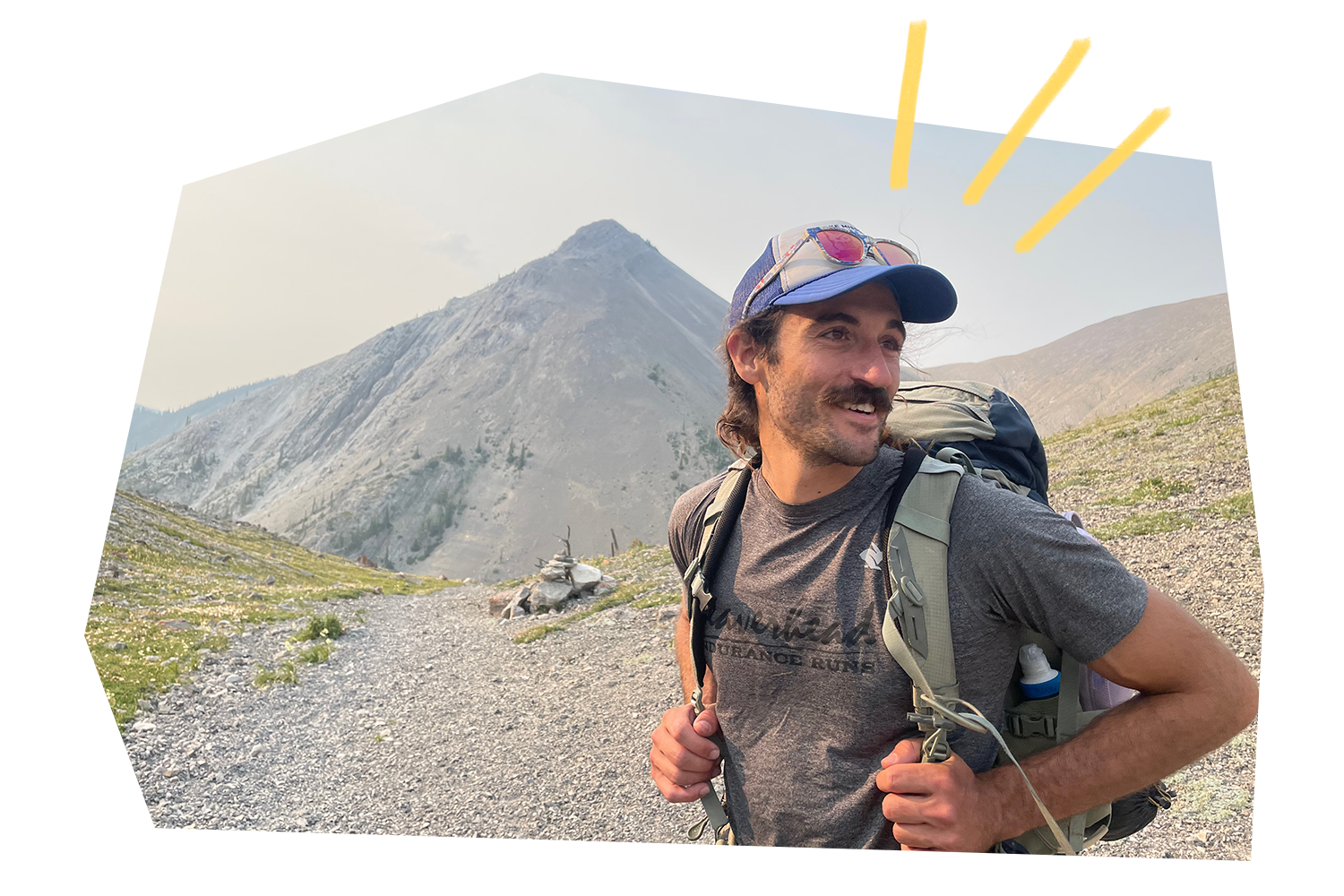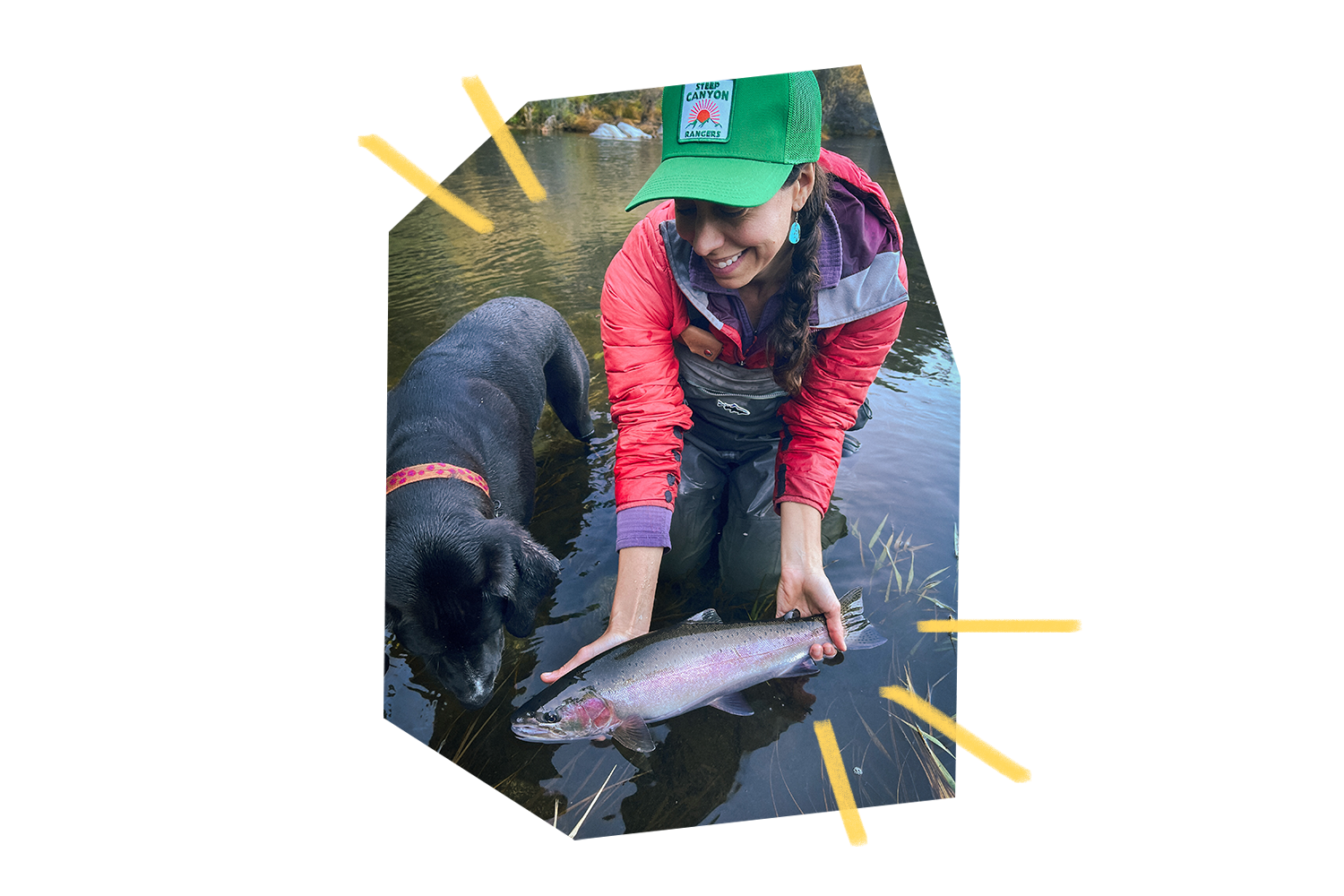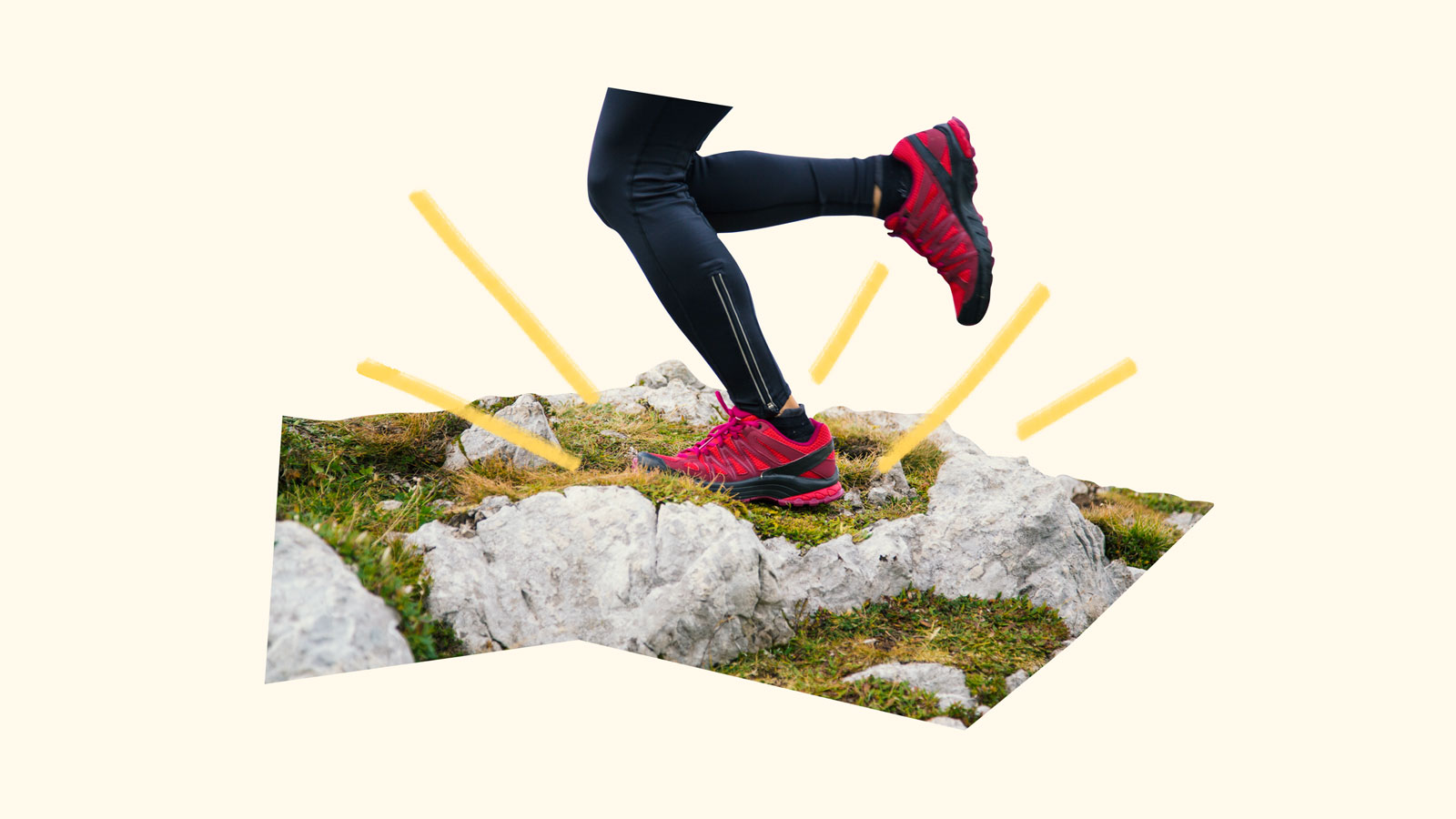Joy can strengthen our resolve, help us unlock creativity, and bolster our resilience. In Fix’s Joy Issue, we explore the importance and power of finding joy in the face of grief, anger, and a changing climate.
Jeff Mogavero remembers the exact moment he fell in love with trail running. He was a junior at St. Lawrence University in upstate New York, studying conservation biology and running cross-country. One Friday afternoon, he drove 90 minutes to the Adirondacks to hit a favorite mountain trail. With a bluebird sky above and a nippy but pleasant wind all around, Mogavero started laughing as he galloped downhill.
It wasn’t the athletic pursuit that captured his imagination, but the unfettered joy of being enveloped by nature and feeling like a part of something bigger than himself. He immediately knew he must help others find the same happiness and wonder. “This is what I want, and I want everyone to have this,” he remembers saying aloud to himself. “I need to find a way to help everyone experience this.”
In the seven years since Mogavero made that discovery, he has come to realize that ensuring others can find their happiness outdoors means defending those spaces. Those two missions are so inextricably linked that he can’t quite sort out “which came first, my love of the outdoors, or this feeling of responsibility” to preserve the places where he plays. When he isn’t skiing, river surfing, cycling, or running, Mogavero maintains the trails in the mountains around his home in Missoula, Montana, participates in Clark Fork River preservation campaigns, and promotes sustainability and climate solutions within the community.
[Read more: How one organization in Missoula is tackling exclusion in the outdoors]
The professional endurance athlete concedes to self-serving motives for his advocacy: Ever-hotter temperatures and increasingly severe droughts will make it difficult, if not impossible, to engage in the sports he loves. “It’s very selfish, but that’s OK I think,” he says. “The power in the outdoor community is that every new person who falls in love with a place or an activity is someone else who wants to see those places protected.”
Elite athletes and amateurs alike represent the next wave of the climate movement, drawn to the fight by their passion for the outdoors and a fear that the sports they so love are being compromised. Protect Our Winters, an environmental advocacy organization based in Boulder, Colorado, calls these burgeoning advocates “the outdoor state.”
This increasingly vocal community could represent as many as 57 million people who participate in outdoor recreation or work in the industries that support it, says Mario Molina, the organization’s executive director. This untapped coalition runs the gamut from extreme sports enthusiasts to backcountry hunters and anglers, and spans the political and social spectrum. That could make it the nation’s largest — and most cohesive — electoral constituency, if activated.
“This group is particularly passionate about the places that they recreate in and the benefits that recreation brings them,” Molina says. “And they are passionate about seeing them protected.”
But being honest participants in the movement means grappling with their own contributions to climate change. Many of the activities they so adore tread heavily on the environment, and traveling great distances to remote locales to engage in them brings its own ecological and climate costs.
Experiencing climate change
Mogavero has always had an affinity for the outdoors, and for doing what he can to preserve those spaces. In high school, where Mogavero kindled his love of running, he led the environmental awareness club, started his school’s recycling program, and was named “most likely to solve humanity’s problems” upon graduation. In the years since, he has spent every available moment outside.
Given all that, it’s little surprise that he would feel called to climate action. After all, research has found a direct relationship between time spent in nature and the likelihood of becoming an environmental steward. A study published last year concluded that a single “outdoor journey” of at least one week acts as a catalyst, making people feel more connected to their physical surroundings and enhancing their desire to improve the environment.
[Read more: Stories of the outdoor experiences that inspired climate leaders]
Watching hazy air get trapped in the valley in which Missoula sits, Moagvero brought Running Up for Air — a nationwide series of trail races that raise money for local climate organizations and increase awareness of air quality issues — to town. The city held its second event in February, raising $16,000 (nationally, the series has raised more than $100,000 since 2016).

If spending just seven days outdoors can spark such intense interest, imagine what a lifetime can accomplish. Runners, anglers, skiers, hunters, and others who derive great joy from playing in the mountains, at the lake, or even in the park up the street see these places changing before their eyes. The climate crisis poses an existential threat to many of the activities that define them.
“These days, my whole sense of identity is the outdoor world, and the sports we practice in the outdoors are what brings us together,” says Dakota Jones, a professional trail runner who lives in Bozeman, Montana. “We see in a very tangible way how climate change is affecting everything.”
Jones’s identity as an environmentalist is rooted in the works of Henry David Thoreau and John Muir. Running allows him to experience the natural abundance and quiet introspection those early environmentalists championed in their writing. But it also reveals how climate change is slowly taking that all away: Trails take him along parched rivers, scorched forests, and shrinking snowpacks.
“If climate change continues to progress as it is, we are going to live in a world that has much scarcer resources than anything we could imagine,” Jones says. “It is going to result in us having a whole lot less opportunity and a lot more uncertainty.”
With every cast of her fly rod, angler and filmmaker Katie Falkenberg is reminded of that fact. Warming temperatures threaten iconic cold-water fish like steelhead and cutthroat trout. Droughts reduce water levels, eliminating the pools and eddies where they seek refuge. She has seen fewer trout in streams that once teemed with them, and some of her favorite spots are too warm or too low to fish responsibly. The North Umpqua River, a world-class trout river in Oregon, was closed for most of the season last year for exactly that reason.
“My first reaction is that it makes me sad and frightened,” Falkenberg says. “But more than anything, what it does is light a fire under me and make me feel this urgency to act.”

Falkenberg cherishes the lessons angling teaches about the natural world and the indescribable “brush with the wild” that comes with catching and releasing a fish. She wants to ensure future generations experience that thrill, and makes documentary films that explore the impacts of climate change to spread the word.
“It gives me the opportunity to bring awareness to the issues I care most about, and hopefully make other people care as well, or at least gain a deeper understanding,” she says. “And that brings me joy, but in a way that it also brings an incredible amount of responsibility.”
The vast array of businesses that cater to outdoor enthusiasts like Falkenberg are grappling with the impacts of climate change as well. Whitewater rafting guides see entire seasons altered by diminished snowpack. Mountain-biking and trail-running race organizers must revise or even scrap their plans when fires erupt. But perhaps nowhere does climate change pose a greater threat than to skiing.
Between 1955 and 2020, snowpack in the western United States during the month of April decreased by 86 percent. Climate change has already reduced the average ski season by 34 days nationwide. That has many ski resorts mobilizing — both as a means of survival and a way of enlisting patrons in the climate movement.
Alterra Mountain Company is exploring ways of making transportation, energy use, and waste more sustainable at its 15 resorts in the U.S. and Canada. Aspen Skiing Company, which owns four destinations in Colorado, works with a local mine operator to trap waste methane and use it to generate electricity. (The collaboration prevented 250 billion cubic feet of the potent greenhouse gas from being released into the atmosphere last year.) Berkshire East Mountain Resort in Massachusetts generates all of its own electricity from on-site renewable sources.
Karen Sanford, the chief legal and social responsibility officer at Alterra Mountain Company, describes such efforts as the “confluence for thought leadership and good citizenship when it comes to climate change.” The industry, she says, has an “opportunity and responsibility to connect with millions of people every year.”
Grappling with the impact of outdoor recreation
Even as athletes and businesses take increasingly ambitious steps to mitigate climate change, they are acutely aware of the impact their beloved sports have on the planet. Ski resorts, for example, are an obvious source of CO₂ because they rely heavily on fossil fuels for basic operations. And then there are the untold emissions generated by the millions of visitors to remote resorts and other destinations in the pursuit of outdoor activities.
But less energy-intensive sports can have outsized impacts. One study found that trail-running races can “significantly” degrade the area around the trails and kill protected plants and wildlife. Guests at the 423 sites run by the U.S. National Park Service generate more than 100 million pounds of waste annually. Research shows that even camping and hiking can have a detrimental impact on biodiversity.
Jones understands that running through forests and meadows can have an adverse impact on ecosystems, and he’s painfully aware of the emissions involved in reaching races. He has gone to occasionally extreme lengths to reduce his carbon footprint by, say, biking the 250 miles to the Pikes Peak Marathon and taking a cargo ship to an event in Europe rather than flying.
“I do have a big impact, but I have tried to make these big gestures occasionally,” Jones says. “I get that a couple tanks of gasoline is nothing in the large scheme of things, and that it isn’t scalable.”
For her part, Falkenberg sometimes wonders if the best way to protect wild spaces and mitigate climate change is to stay away from them. But she also believes that denying people an opportunity to experience places like the North Umpqua River would leave fewer people invested in defending them.
“I am more inspired to work to protect it when I am out there fly fishing,” she says. “Going forward, we have so much work to do, but people coming together around being informed gives people hope and can spur action.”
Advocating for systemic change
That idea is at the core of Protect Our Winters. The organization, founded in 2007 by professional snowboarder Jeremy Jones, believes the size and passion of the nation’s outdoors enthusiasts is an untapped resource in the climate fight. It tries to harness the power of the “outdoor state” through campaigns calling for sweeping policy changes rather than individual actions.
Representatives with the nonprofit regularly meet with lawmakers and policymakers in Washington, D.C., and state capitals to push for stricter emissions standards, greater investment in green infrastructure, more sustainable labor practices, and more.
“There’s a lot of progress we can make by taking individual action, but what we really need is a complete shift,” Molina, of Protect Our Winter, says. “Changing our energy mix would have an impact at scale that is orders of magnitude greater than what we can have at scale individually because of the choices we can’t make.”
The organization also sends “athlete ambassadors” to Congress and statehouses nationwide, endorses candidates with favorable climate action platforms, and hosts community education events during key legislative efforts and during election seasons. A core part of its work focuses on converting interested bystanders into active participants in climate action, however that looks for them.
For Dakota Jones, that conversion included launching Footprints last summer. The weeklong camp introduced trail runners with a passion for climate action to mentors in the climate space and resources to address environmental challenges within their communities. The name acknowledges that outdoor activities — like modern lives in general — create an impact on the natural world, and the goal is to tread as lightly as possible.
“After Pikes Peak, I realized my individual impact isn’t enough, and I need to make it collective,” Jones says.
Mogavero takes a different tact. He doesn’t identify as a climate activist, but as someone trying to do the right thing — “and that means showing up,” being an example for others, and taking steps, however small, to mitigate climate change so he might continue to enjoy playing outdoors.
“There’s something empowering about doing it on a daily basis,” he says. “Maybe it doesn’t make a significant difference, but it can still help you have hope.”
Explore more from Fix’s Joy Issue:
- When children imagine the future, a world of climate possibilities emerges
- What the rich inner lives of dolphins can teach us about climate solutions
- Happy Climate is on a mission to show what we gain from climate action




